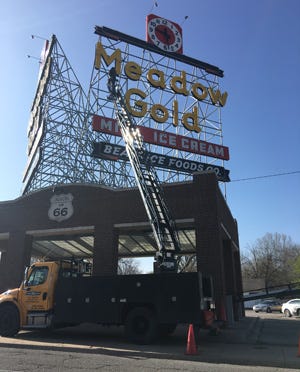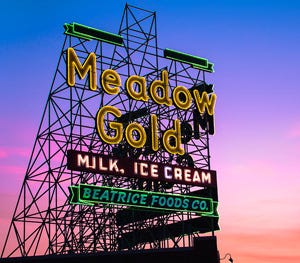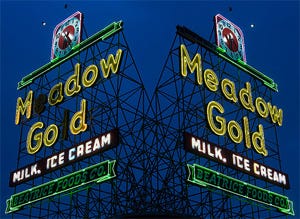Iconic Meadow Gold clocks are back
The National Park Service (NPS) granted $15,000 of the $322,273 necessary to move and restore the Meadow Gold sign in Tulsa. The final piece of that work is complete as modern clocks are now installed on the structure.
NPS notes that neon signs are among the most evocative of Route 66 icons, but for decades many have been threatened by neglect or demolition. Tulsa commemorates Route 66 and those neon signs in a special plaza at 11th Street and Quaker Avenue, just a mile west of the sign’s original location.
The Meadow Gold sign advertised dairy products beginning in the 1940s for the Beatrice Foods Company. With two 30-by-30 faces, the sign was the largest neon display in Tulsa at the time of its construction.
The Meadow Gold sign went dark in the 1990s and faced demolishment when a car dealership purchased the midtown location.
Through the efforts of preservationists, Tulsa County's Vision 2025 Program, the Oklahoma Route 66 Association, and the larger Tulsa community, the sign was dismantled and donated to the Tulsa Foundation for Architecture.
A new home with commemorative plaques was built on 11 Street (old Route 66) and Quaker Avenue. This open sided building is a low, one-story brick support pavilion that includes a prominent Route 66 road sign embedded in its mantel. However, the clocks had disappeared and could not be installed.
It is a mystery when and how the clocks disappeared. It depends on who you ask as some assert they were gone before the sign was removed and others suggest "they walked off" during storage and restoration. Regardless, the new clocks look great.
NPS notes, "Restoration work on the sign included repairs to the metal and porcelain that composed the letters, and replacement of the deteriorated metal bar structures. New neon was also incorporated into the sign.
Because of this effort, the old Route 66 corridor in Tulsa, which runs for 24 miles through the city, now has a bright new anchor and symbol of the importance of the old road in the history of the city." Click here to read more and see photos of the restoration process from the National Park Service.
The original installation of the sign (without the clocks) on the support pavilion in 2009 was covered locally by KOTV's Rick Wells and may be found online by clicking here.







